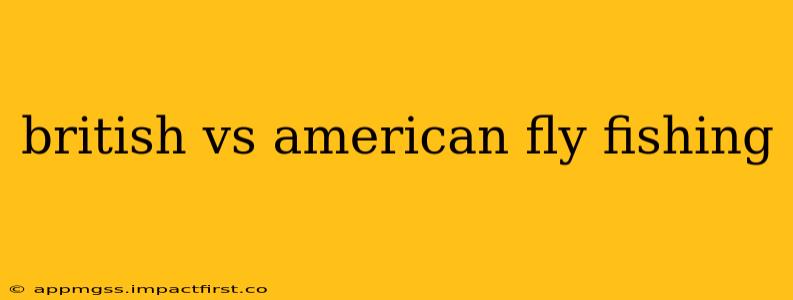Fly fishing, a sport steeped in history and tradition, boasts distinct styles across the globe. This post delves into the fascinating differences between British and American fly fishing, exploring techniques, equipment, and the overall ethos of the sport in each country. While both share the core principles of fooling fish with artificial flies, subtle—and sometimes significant—variations distinguish their approaches.
What are the Key Differences Between British and American Fly Fishing?
This is a broad question, encompassing many facets of the sport. The key differences lie primarily in the types of water fished, the preferred techniques, the equipment used, and the overall angling philosophy. British fly fishing often focuses on smaller, more technical waters, employing delicate presentations and precise casting techniques. American fly fishing, while incorporating these aspects, also emphasizes larger rivers and lakes, often involving more powerful casts and larger flies.
What are the Different Fly Fishing Techniques Used in Britain and America?
British Fly Fishing Techniques: British anglers are renowned for their mastery of delicate presentations. Techniques like the roll cast, which allows for casting in confined spaces, are frequently employed. The emphasis is on stealth and precision, aiming for subtle presentations to wary fish in often heavily pressured waters. Nymphing, particularly using indicator methods, is a staple technique, mirroring the natural drift of insects in the water column.
American Fly Fishing Techniques: American fly fishing encompasses a broader range of techniques. While delicate presentations remain important, particularly in smaller streams and spring creeks, techniques like the overhead cast are more prevalent due to the often wider, faster-flowing rivers. Streamers (large artificial flies imitating baitfish) are frequently used, requiring powerful casts to cover significant distances. Dry fly fishing is also popular, but may involve fishing larger dries on faster currents compared to the British approach.
What are the Main Types of Flies Used in British and American Fly Fishing?
British Flies: British fly patterns often emphasize realism and subtlety. Smaller, more natural-looking patterns imitating specific insects prevalent in British waters are common. Traditional patterns, passed down through generations of anglers, remain highly effective.
American Flies: American fly patterns exhibit a wider range of sizes and styles, often reflecting the diverse aquatic insect life and the presence of larger prey fish. While realistic imitations are important, larger, more provocative patterns are also used effectively. This is especially true in techniques such as streamer fishing.
What Kind of Equipment is Used in British and American Fly Fishing?
British Equipment: British anglers often favor lighter, more delicate equipment. Rods are typically shorter and lighter in action, reflecting the need for precise control in smaller streams. Reels are often smaller and more compact.
American Equipment: American anglers tend to use heavier equipment, especially when fishing larger rivers and lakes. Longer, more powerful rods are common, allowing for longer casts and the ability to handle larger fish. Reels are frequently larger and more robust, providing increased line capacity.
What is the Overall Philosophy of Fly Fishing in Britain and America?
British Fly Fishing Philosophy: British fly fishing is often associated with a more traditional and conservationist approach. Respect for the environment and the fish is highly valued. A strong emphasis is placed on preserving the integrity of the fishing waters.
American Fly Fishing Philosophy: American fly fishing embraces a wider spectrum of approaches, from purist dry fly fishing to more aggressive techniques like streamer fishing. While conservation is growing, there’s sometimes a greater emphasis on the sheer challenge and excitement of the sport itself.
Is One Style Better Than the Other?
There is no single "better" style; the best approach depends on personal preference, the type of water being fished, and the desired angling experience. Both British and American fly fishing traditions offer unique and rewarding experiences. The beauty lies in the diversity of styles and approaches, each reflecting the specific environments and angling cultures they've evolved from. Understanding these differences allows anglers to appreciate the richness and depth of this fascinating sport, no matter where in the world they cast their line.
